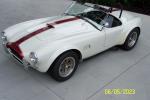 
 Main Menu
Main Menu
|
 Nevada Classics
Nevada Classics
|
 Advertise at CC
Advertise at CC
|
 November 2025
November 2025
|
| S |
M |
T |
W |
T |
F |
S |
| |
|
|
|
|
|
1 |
| 2 |
3 |
4 |
5 |
6 |
7 |
8 |
| 9 |
10 |
11 |
12 |
13 |
14 |
15 |
| 16 |
17 |
18 |
19 |
20 |
21 |
22 |
| 23 |
24 |
25 |
26 |
27 |
28 |
29 |
| 30 |
|
|
|
|
|
|
|
 CC Advertisers
CC Advertisers
|
|

10-12-2007, 08:44 PM
|
|
CC Member / Sponsor

|
|
|
Join Date: Jan 2002
Location: Provo,
UT
Cobra Make, Engine: HiTech Legends GT500
Posts: 1,359
|
|

 Not Ranked
Not Ranked

Quote:
|
Originally Posted by mrmustang
Tom,
...the placement of the O2 sensor plays a critical role in how accurate your readings will be. Mismeasurements by as little as one half and inch in either direction can mess up your readings by as much as +/- 10-15%.
Bill S.
|
Please explain. I have never heard of the placement being so critical.
NGK says
http://www.ngksparkplugs.com/pdf/AFX...ual_REV_06.pdf
"The AFR sensor should be located between 12” and 48” from the engine, upstream of any catalyst device if so equipped. The closer the sensor is to the engine, the more likely it will be overheated, possibly shortening its life. The further it is from the engine, the more likely condensed water will get into the sensor and thermally shock it, again possibly shortening its life. The sensor should be mounted at least ten exhaust diameters upstream of the exhaust exit (ex. for a 3” exhaust pipe, that is 30”). If the sensor is mounted between one and ten exhaust diameters from the exhaust exit, the AFR measured will be leaner than the actual AFR by as much as 2 AFR at low engine speeds (i.e. less than 3000 rpm)." |

10-12-2007, 09:09 PM
|
 |
CC Member/Contributor

|

|
|
Join Date: Feb 2000
Location: Greenville,
SC
Cobra Make, Engine: 70 Shelby convertible, ERA-289 FIA, ERA 289 roadster hybrid, mystery Ford powered 2dr convertible
Posts: 12,770
|
|

 Not Ranked
Not Ranked

Quote:
|
Originally Posted by Tom Kirkham
Please explain. I have never heard of the placement being so critical.
NGK says
http://www.ngksparkplugs.com/pdf/AFX...ual_REV_06.pdf
"The AFR sensor should be located between 12” and 48” from the engine, upstream of any catalyst device if so equipped. The closer the sensor is to the engine, the more likely it will be overheated, possibly shortening its life. The further it is from the engine, the more likely condensed water will get into the sensor and thermally shock it, again possibly shortening its life. The sensor should be mounted at least ten exhaust diameters upstream of the exhaust exit (ex. for a 3” exhaust pipe, that is 30”). If the sensor is mounted between one and ten exhaust diameters from the exhaust exit, the AFR measured will be leaner than the actual AFR by as much as 2 AFR at low engine speeds (i.e. less than 3000 rpm)." |
Tom,
Placement up or down stream, just as placement in one header tube vs another will cause readings that are not accurate. NGK, Bosch, and several other sellers of these aftermarket "inexpensive" aftermarket O2 sensors will tell you differently, but having had access (while still living in NJ) to a computerized chassis dyno with an operator who was properly trained show me the error of my ways. Where we would want a air/fuel ratio of 12-14 in a reading, the O2 sensor (mounted in a bung in the proper place according to the manufacturer showed one reading, while the O2 sensor in the end of the header (actually 2 feet in just after the 4X4 collector dumped into the muffler assembly showed another. Tuning with the original O2 (bunged) showed me to be running rich, when in fact I was running lean. Again, being able to set an RPM or a speed on the chassis dyno so that we could tweak any carb I had installed (4 on one particular 427 side oiler engine one weekend) was the most beneficial thing that I could have happen. Trying to tune without that load on the engine (drivetrain load vs engine rpm only) turned out to be my downfall for one over the other.
Bill S.
__________________
Instead of being part of the problem, be part of a successful solution.
First time Cobra buyers-READ THIS
|

10-12-2007, 09:18 PM
|
 |
CC Member

|
|
|
Join Date: May 2004
Location: Palm Coast,
FL
Cobra Make, Engine: Shelby American CSX 4241 - authentically built
Posts: 2,573
|
|

 Not Ranked
Not Ranked
Bill, the placement is only critical for a factory HEGO with an EFI system, because it needs to know the pulse delay from the head to the sensor. For reading A/F, it does not matter where the sensor is in the exhaust, as long as there are no leaks.
Tom, the LM-1 is neat, but I have found them to be "off" in their readins from actual A/F. But if you can compare it to a known good setup, the mis-reading is linear, so if you know how much it's off (as much as .5 A/F in some cases), then you can still use it.
I like the Dynojet Wideband Commander, because it's a good price and comes with many features that cost way more on most systems.
__________________
Sal Mennella
CSX 4241, KMP 357 - sold and missed, CSX 4819 - cancelled, FFR 5132 - sold
See my car at CSXinfo.net here >> CSX 4241
|

10-12-2007, 10:14 PM
|
 |
CC Member

|
|
|
Join Date: May 2004
Location: san jose,
ca
Cobra Make, Engine: spf #1723 427w
Posts: 421
|
|

 Not Ranked
Not Ranked

Randy's right, The best place is in the collector. Two bungs are needed, one in each side for each bank. The LM1 is a great tool. first calibrate the sensor in free air...Easy to do. Then do one bank at a time. First test at idle. DO NOT use the clamps at the end of the exhast pipe as there is too much "free air" and the reading will be way too lean, probably 20 or more ( 20 parts air to 1 part fuel). Adjust your needle valves till the meter reads approx 14.2-14.5AFR. Next step is to go drive the car under load. The recording of the LM1 is great at this point as you can concentrate on driving instead of watching the meter. The number to shoot for is 13.5 AFR. My car was around 12(TOO RICH). I went down two jet sizes in the primaries and drove the car again. Bingo, 13.5!. Now WOT (wide open throttle). Find somewhere that is SAFE and open her up. The number to shoot for is around 12.5. You will be and should be on the rich side as you want to dump gas in. I was at 11. Down two jet sizes in the secondaries and right on 12.5!. Test the other bank the same way. Now I get better gas milage and unbeliavabley better performance with no stumble. There are alot of great features on the LM1. Rpm and graphing make it easy to use. Hope this helps for basic info.
Greg
__________________
Greg spf 1723
Last edited by Greg tripp; 10-12-2007 at 10:27 PM..
|

10-12-2007, 10:59 PM
|
|
CC Member / Sponsor

|
|
|
Join Date: Jan 2002
Location: Provo,
UT
Cobra Make, Engine: HiTech Legends GT500
Posts: 1,359
|
|

 Not Ranked
Not Ranked
Sal,
How did you tune your car? What did you do about the slip fit connectors on the headers?
I found this on Google (5th one down) about the Wide Band Commander  http://www.powersurgeperformance.net...products_id=28
http://www.powersurgeperformance.net...products_id=28 |

10-12-2007, 11:18 PM
|
 |
CC Member

|
|
|
Join Date: May 2004
Location: Palm Coast,
FL
Cobra Make, Engine: Shelby American CSX 4241 - authentically built
Posts: 2,573
|
|

 Not Ranked
Not Ranked
Quote:
|
Originally Posted by Tom Kirkham
|
I used the a/f setup on my Dynojet chassis dyno, with the tailpipe probe, about a foot into the side pipe.
__________________
Sal Mennella
CSX 4241, KMP 357 - sold and missed, CSX 4819 - cancelled, FFR 5132 - sold
See my car at CSXinfo.net here >> CSX 4241
|

10-13-2007, 04:23 AM
|
 |
CC Member/Contributor

|

|
|
Join Date: Feb 2000
Location: Greenville,
SC
Cobra Make, Engine: 70 Shelby convertible, ERA-289 FIA, ERA 289 roadster hybrid, mystery Ford powered 2dr convertible
Posts: 12,770
|
|

 Not Ranked
Not Ranked
Quote:
|
Originally Posted by Power Surge
I used the a/f setup on my Dynojet chassis dyno, with the tailpipe probe, about a foot into the side pipe.
|
Exactly 
__________________
Instead of being part of the problem, be part of a successful solution.
First time Cobra buyers-READ THIS
|
 Posting Rules
Posting Rules
|
You may not post new threads
You may not post replies
You may not post attachments
You may not edit your posts
HTML code is Off
|
|
|
All times are GMT -7. The time now is 12:45 AM.
|





















 Hybrid Mode
Hybrid Mode


